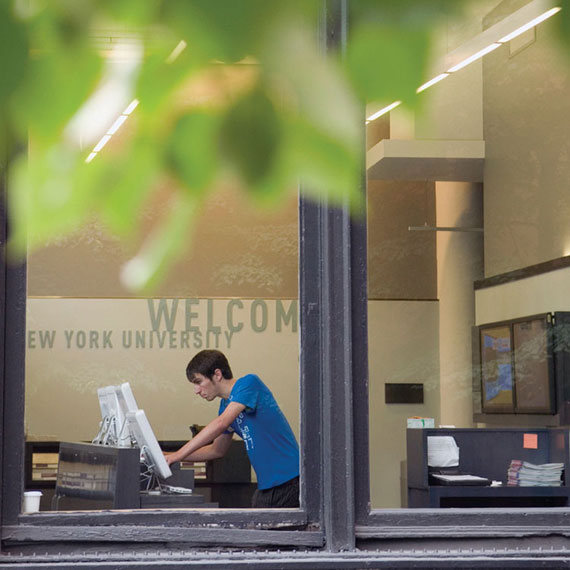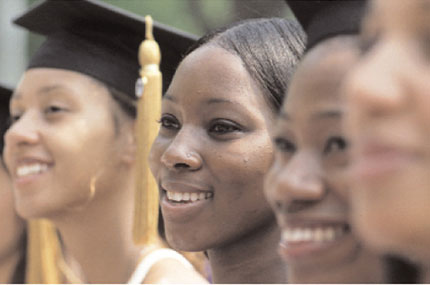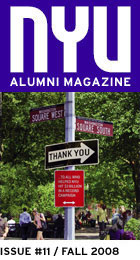Unfinished Business
As tuition and the cost of living climb, NYU considers how to keep its doors open to deserving students
by Courtney E. Martin / GAL'04

Marissa Maislen (TSOA ’09), a dance major from Seattle, was a typical college freshman in 2006 when everything changed in one day. Her father was in a serious car accident, which prevented him from working, and the medical bills began piling up at home. She scrambled to make extra money—taking a job at the reception desk in her residence hall, doing tech work on Tisch School of the Arts summer shows, and even posing as a model for drawing students at the School of Visual Arts. But Maislen still struggled to keep up with a load of college expenses. “I began to realize it was possible that I might not get to continue at NYU,” she says.
While Maislen’s family circumstance might be unusual, her challenge to pay for college is not. Though NYU allocates about $249 million in financial aid each year, 80 percent of undergraduates work one part–time job, 25 percent work two, and almost 500 students work three. For many, these gigs only help to scrape the surface of their mounting debt. Some resort to transferring or choose not to attend NYU, which endangers the university’s historic identity as a place where anyone could get an education—where a middle–class kid from Toledo, Ohio, might learn side by side with a recent immigrant from Bangladesh and an heiress from the Upper East Side. For decades, this eclecticism has helped ensure class discussions are infused with multiple perspectives and new ways of thinking. “One of NYU’s wonderful attributes is the diversity of our student body—geographically, ethnically, culturally, and we would hope, economically,” says Barbara F. Hall, associate provost for enrollment management. “But that’s going to become much more difficult if we can’t increase our scholarship funding.”
The good news is that last year NYU received more applications than any private school in the country and is now competing head–to–head with the biggest players in the higher ed game. Last spring’s admissions pool confirmed that many of the same students vying for a coveted spot on Ivy League campuses are also holding their breath for a fat envelope from NYU. The bad news: The university can’t afford them. In the last admissions cycle, it may have lost 69 students to Harvard, 56 to Princeton, and 68 to Brown because they offered a far better financial package.
Some may wonder: What happened to the American dream, where a promising student might work his or her way through college? “Twenty years ago, that was possible,” says Debra A. LaMorte, senior vice president for university development and alumni relations, who used the “bootstrap” approach to get through both college and law school. “Today, the scale has changed.” Indeed, one year at NYU as an on–campus undergrad now costs $51,982. And, of course, being in the heart of the city is one of the school’s biggest assets, but it also burdens students with a steep cost of living.
 Left: Getting acquainted with campus in the Jeffery S. Gould Welcome Center.
Left: Getting acquainted with campus in the Jeffery S. Gould Welcome Center. Right: The new “Call to Action” aims to keep NYU ethnically, culturally, and economically diverse.
In response, the Office of Development and Alumni Relations has launched “NYU’s Call to Action,” a new fundraising effort to support scholarships, fellowships, and financial aid. While many donors already invest in the labs and centers where researchers work to cure disease, resolve conflict, and address poverty, it’s the students themselves who will realize many of these achievements. “There is a ripple effect that goes with aiding students,” LaMorte explains. “You influence a bright young person’s life and they, in turn, go out and influence others who are also eventually inspired to give back.”
And the competition among universities to attract students who will be agents of progress is on the rise. According to The New York Times, the number of high school graduates seeking college admission will finally peak next year, after a 15–year climb, and then continue to decline until 2015. That means that students will actually enjoy, as University of Vermont president Daniel M. Fogel puts it, a “buyer’s market.” Anticipating this shift, some of the nation’s leading universities have begun instituting more generous financing policies. Harvard now offers full funding to any student from a family whose income is $60,000 or less, and charges those with household incomes from $120,000 to $180,000 just 10 percent of their family household income per year. Yale and many others have followed suit.
 A moment of triumph at commencement, relieving finals stress in Weinstein Hall.
A moment of triumph at commencement, relieving finals stress in Weinstein Hall.
NYU does not have this financial luxury. Despite a healthy $2.161 billion endowment, which ranks #31 in the nation, the endowment per student is only $62,053, a rate that places it #202 in the country. This forces NYU to rely on tuition to fund 60 percent of its annual budget, far more than any of its peers. And though the recent $3 billion, seven–year fundraising campaign met almost all of its myriad goals, student aid proved to be the frustrating exception. The campaign raised only $362 million of an anticipated $650 million to support scholarships, and left development of ficers and school leaders with a profound question: How do you connect those with resources to those without? “You can touch a building that you’ve helped build,” says campaign chair Joel S. Ehrenkranz (LAW ’61, ’63) of the conundrum. “You can talk to the professor whose position you’ve endowed. But when you give to the scholarship fund, it’s more complex. Who are you identifying with?”
One way to make this connection has been an annual scholarship luncheon for donors and students, but NYU administrators are also finding new ways to bring together their most inspired donors and those young people who benefit from their generosity. Trustee Phyllis Putter Barasch (STERN ’81), who, along with her husband Marvin Barasch (STERN ’47), named the Barasch Theater in NYU’s Jeffrey S. Gould Welcome Center, remembers the impact of a presidential roundtable luncheon: “It was absolutely eye–opening to hear these students speak firsthand about the struggle to simply grow up and get an education. They make the daily grind of trying to figure it all out financially very real.”
Having grown up poor in rural Maine, Constance Silver (SSSW ’78, ’79), who last year, with her husband Martin Silver (STERN ’58), gave the largest–ever private donation to a school of social work in the United States—$50 million—to establish the Constance McCatherin–Silver Fellowship and the McSilver Institute for Poverty Policy and Practice, already had a strong understanding of students’ struggle. She worked for an airline until she was 34 years old, when her neighbor and mentor—a tiny social worker in threadbare clothes—convinced her that she was college material. Two NYU degrees and a PhD from the Union Institute & University later, Silver has focused on aiding aspiring social workers from low–income families who will, in turn, use their education to help their home communities. Evan Chesler (ARTS ’70, LAW ’75), who established the Barbara and Evan Chesler Scholarship in Pre–Law, is also investing both time and money in future leaders and hosted a roundtable discussion with his scholarship recipients. Chesler received a university scholarship, which he says “was literally the difference between getting a college education and not having that opportunity.” As the “Call to Action” moves forward, NYU continues to explore options that will excite donors to name scholarships, “adopt a student” for four years, or simply donate to the Fund for NYU, the university’s chief source of unrestricted income. The student stories are always compelling; the challenge is making sure they’re heard. Marissa Maislen, who now benefits from a C.V. Starr Scholarship, will audition for dance companies in New York or Europe when she graduates next spring. “That scholarship made all I want to do possible,” she says. “It made it seem like they wanted me to have this chance.”
How do you connect those with Resources to those without?







